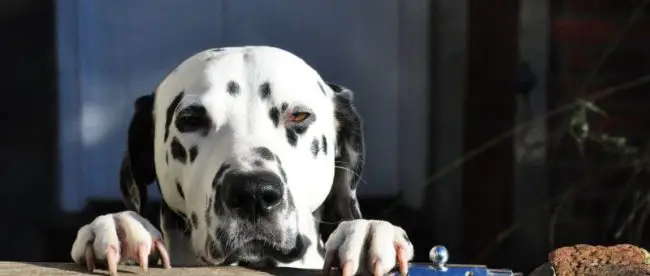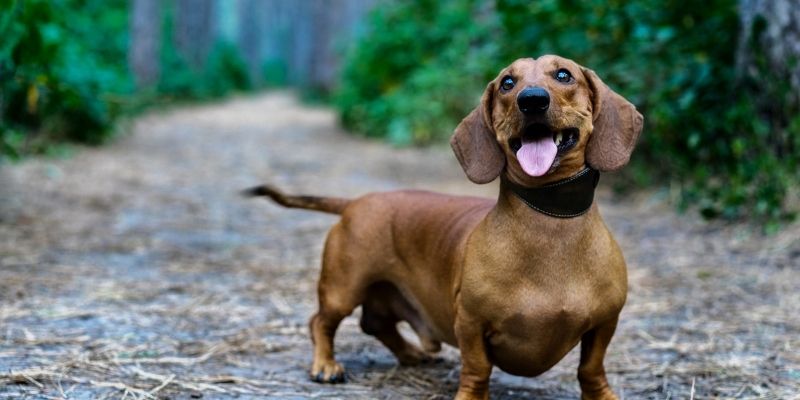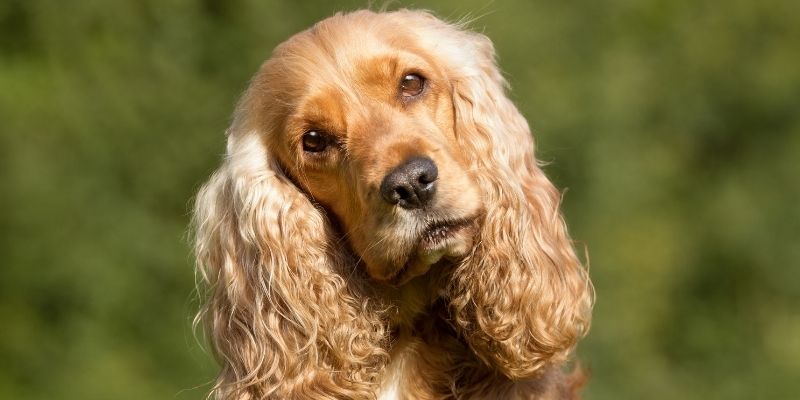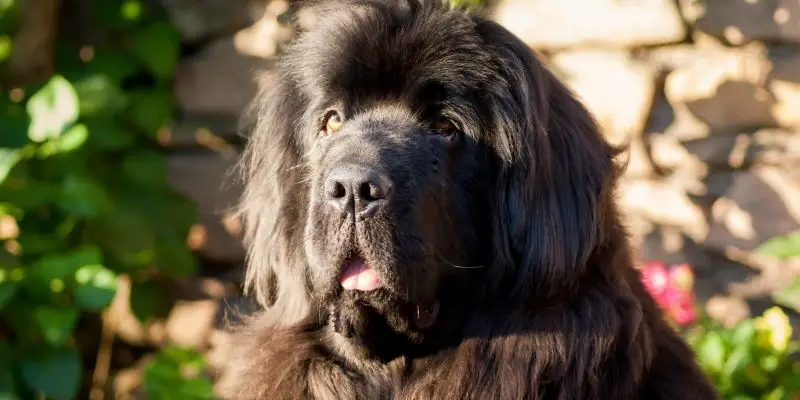15 Dog Breeds with Webbed Feet (and Why Dogs Need It?)

A dog’s paw webbing is a membrane of connective tissue and skin that connects the dog’s toes.
You’ve probably heard of a few creatures having webbed feet, but did you realize that most terrestrial mammals are born with them?
While most species lose the majority of their webbing before birth, every dog breed keeps some (albeit you won’t notice it in most breeds).
In rare circumstances, dogs and other animals can be born with all of their webbing intact. Dog breeders have taken advantage of this birth abnormality by breeding dogs to produce puppies with webbed paws.
Webbed feet can help dogs dig and swim more efficiently since the webbing allows them to paddle faster and be more regulated in the water.
Do you have a specific question about the dog breeds with webbed feet? Then use the table of contents below to jump to the most relevant section. And you can always go back by clicking on the black arrow in the right bottom corner of the page. Also, please note that some of the links in this article may be affiliate links. For more details, check the Disclosure section at the bottom of the page.
Here's what we'll cover:
You can see how webbed feet may be pretty valuable if a breeder aimed to make dogs that could work in and around water (such as search and rescue dogs).
Webbed feet can help dogs swim more efficiently since the webbing allows them to paddle faster and be more regulated in the water.
Webbed feet could be pretty valuable for breeders wanting to make dogs that can work in and around water (such as search and rescue dogs).
Now that you’re aware of some of the advantages of webbed feet let’s look at some of the most renowned dog breeds with webbed feet!
American Water Spaniel
These adorable pups were raised to withstand the chilly waters and marshy shores of the Great Lakes region in the United States. These dogs originated in the United States, as the name says. They were invented in the nineteenth century in the state of Wisconsin.
The American Water Spaniel is a versatile hunting dog bred to retrieve ducks from boats or canoes. Lovers of this breed report that they swim like seals due to their bodies being developed for the purpose.
The toes are said to be firmly packed, webbed, and heavily cushioned. In addition, the coat has an undercoat layer to offer sufficient density and weather and water protection.
Chesapeake Bay Retriever
<iframe width=”560″ height=”315″ src=”https://www.youtube.com/embed/bhaKYKxDZcs” title=”YouTube video player” frameborder=”0″ allow=”accelerometer; autoplay; clipboard-write; encrypted-media; gyroscope; picture-in-picture” allowfullscreen></iframe>
These pups live on the East Coast of the United States (Chesapeake Bay) and are used to chasing ducks in the freezing seas while staying warm, thanks to their coats.
It goes without saying that these canines were required to be highly robust, often working in the most inhospitable weather conditions, even breaking the ice during their retrievals.
This breed is expected to have ‘fully webbed hare feet of good size with toes well rounded and close,’ according to the American Kennel Club. To provide driving power for swimming, the hindquarters must be exceptionally powerful. The rough outer coat is oily, while the undercoat is woolly, preventing cold water from reaching the Chesapeake’s skin and allowing for faster drying.
The American Kennel Club emphasizes that a Chessie’s coat should be water resistant in the same way that duck feathers are. Shaking the coat after removing it from the water should reveal that it is only damp. A strong desire for water should be present, as stated in the breed’s typical disposition.
Dachshund
The Doxie was designed from the ground up, from its lengthy body to its wide, webbed feet. Even their sharp noses and lop ears aided them in tracking and catching rodents on the farm.
The Dachshund, not recognized for its swimming prowess, uses its webbed feet for something very different.
These long dogs were developed to hunt rodents, a duty that frequently required them to go underground to find their prey. The Doxie’s tiny legs and webbing between their toes helped them to dig faster than other hounds and terriers.
While modern doxies are rarely seen chasing rats into caves, they nevertheless like showing off their digging talents in the garden. These little wienies make terrific household pets as long as you keep their digging inclinations in check.

German Shorthaired Pointer
The German Shorthaired Pointer was developed as the ultimate hunting dog. They can track, point, and retrieve.
The webbing between their toes is helpful in the water. Still, it is even more crucial to allow them to travel easily on saturated soil around ponds and lakes. This characteristic was essential when retrieving downed poultry. Still, it was considerably more crucial while hunting deer and other large animals.
As a pet, the GSP is a high-energy pup who needs something to do. They are terrific sports dogs and make good running and trekking partners. They are loyal and intelligent, and they get along well with children and everyone they encounter.
German Wirehaired Pointer
Selective breeding resulted in a waterproof coat (which insulates them in the winter and cools them in the summer), a fantastic sense of smell, and, you guessed it, webbed feet.
You’ll know these adorable canines by their distinctive beards and dappled fur coats (just look at the charming fellow seen above). Their coats are incredibly easy to care for and require little upkeep.
The German wirehaired pointer, sometimes known as a gun dog breed, is highly energetic, responsive, and intelligent.
It is worthwhile to engage your German wirehaired pointer in an activity such as rally, agility, tracking, or hunting to provide them with adequate brain and body exercise!
It’s also a fun hobby for humans.
Irish Water Spaniel

The Irish water spaniel is last but not least. These pups enjoy swimming, which is not unexpected given their name.
They are one of the oldest spaniel breeds, with origins dating back to the 7th century.
Because these webbed foot dogs have amazing bouncy curls as a coat (which are beneficial for people who suffer from dog allergies), grooming should be introduced early in the dog’s life, so they learn it is a good experience!
Irish water spaniels usually are lovely family dogs who get along well with children. They don’t like being left alone, though, and it can cause separation anxiety.
Labradoodles
You probably already know, love, or own a Labrador retriever. Because of their pleasant, affectionate temperament, they are the most popular breeds and make excellent family pets.
Because of their intelligence and sociability, many Labradors and Lab mixes make excellent service or police dogs. Their grooming routine is also low-maintenance.
They are well-known for being food-oriented and hence relatively easy to train. Still, they will require a lot of exercises to balance their love of food and high energy disposition.
Inadequate exercise and stimulation can cause a Labrador retriever to become hyperactive and destructive, as in many dogs.
Walking them to a safe body of water is a fantastic exercise for a Labrador retriever since it combines their two favorite activities, swimming and retrieving!
Labradors, like the otter, have a double-layered, water-repellent coat, a strong, rudder-like tail to guide them through the water, and huge webbed paws. This successful combo results in fantastic, confident swimmers!
Newfoundland

These huge cuddle bugs were developed in Canada to aid fishermen in the frigid winter waters of Newfoundland. They were frequently employed to pull fishnets, move carts, and other equipment in this location.
Furthermore, because Newfoundlands have a natural predisposition to rescue people from the water, they may be relatively simply trained as lifeguards, rescuing swimmers in distress.
Their webbed toes aid in propulsion, while their tails serve as rudders, and their large fuzzy coats are an added plus.
Surprisingly, this breed uses a different swimming stroke than the average dog. Instead of the typical doggy paddle, the Newfoundland moves his legs down and out, producing more forceful strokes.
Nova Scotia Duck Tolling Retrievers
This breed was established with the goal of hunting ducks, as the name says, and they excelled. However, because of their comparable size and coloration, they are occasionally mistaken for golden retrievers. These dogs, on the other hand, are more copper in color, with patches of white on their faces and chest.
They produced incredibly thick double coatings that are water resistant over time. Like their webbed feet, aids them in swimming through icy cold waters. Nova Scotia Duck Tolling Retrievers have comparable tasks and look similar to their golden counterparts, but their temperaments are vastly different. These canines are more likely to be active and less likely to be friendly to those they meet.
Otterhound
The otterhound is a lesser-known breed that originated in the United Kingdom.
Because of their broad shoulders, rough coats, huge webbed feet, and strong frame, these hunting dogs are excellent swimmers.
Their incredible sense of smell might be put to good use at home with some fun enrichment games!
Despite their working history, otterhounds are gentle and friendly to children and other canines.
Worth thinking about If you’re looking for a one-of-a-kind family member, the otterhound only requires brushing once or twice a week and thrives on praise and goodies. As a result, they excel at learning new skills and fundamental obedience.
Many otterhound owners have expressed a need for a high, secure fence in their garden, owing to their tall, graceful frames, which allow them to jump pretty high.
These dogs aren’t self-starters, preferring to lie on the sofa rather than exercise in the garden; they’ll need some encouragement and lots of walks with good smelling areas!
Poodles

Poodles are a breed that is frequently associated with fashionable city dwellers. Still, they are also surprisingly at ease in the wide outdoors!
In contrast to other dogs with webbed feet, which have oilier fur, the poodle has a very soft, low allergen coat.
It’s crucial to remember that a poodle’s coat requires daily care to keep the fur from becoming matted. But what about the positives? Poodles are a low-shedding breed!
Poodles are one of the most intelligent breeds, making them an excellent choice for agility or obedience training.
They enjoy swimming, so include it in your dog’s workout plan regularly. Poodles have a lot of energy that they need to burn!
Poodles are superb retrievers and were initially designed to retrieve ducks. Their webbed paws allow them to operate quickly and precisely in the water.
Poodles come in a variety of sizes, so you should be able to choose one that is a good fit for your family!
Portuguese Water Dogs
These fuzzy pups with curly coats and webbed toes are just one of many breeds developed to work in the water.
The role of this breed was to aid fishermen in gathering fish into their nets. Not only would they assist in herding the fish into the nets, but they could also rescue broken nets and equipment.
They also served as messengers from ship to ship or ship to shore. In between jobs, Portuguese Water Dogs rode in fishing trawlers from the Atlantic waters of Portugal to the waters off the coast of Iceland, where they aided in cod fishing.
They were typically trimmed in a lion cut to help them work in cold, frigid waters. This traditional cut reduced the first shock of jumping into cold water while providing warmth to the dog’s vital body parts.
The hindquarters were shaved to enable more fluid movement of the back legs and the powerful, rudder-like tail. Their feet were characterized in 1991 as having webbing made of soft skin that was well covered in hair and reached the toe tips.
Redbone
While this breed was not designed for hunting waterfowl, they share the webbed feet feature. This was to aid them in tracking through swamps, marshes, and other wetlands rather than swimming in lakes or ponds. They have been taught to hunt boar, raccoon, bear, and other similar games. Their sense of smell is exceptional, making them ideal trackers.
Redbones may appear familial and social in this scenario, and they are. While appearances can sometimes be deceiving, this is not the case with them. They adore people and are incredibly affectionate. They are completely self-sufficient and capable of entertaining themselves. They do, however, require a healthy outlet for their pent-up energy.
Weimaraner
Have you ever met a Weimaraner and been struck by how poised and graceful they sit?
They could have gotten it from their canine ancestry. In the 18th century, monarchs utilized Weimaraners as hunting dogs. They are bright, caring creatures who make excellent family pets.
Don’t worry. Their regal ancestors haven’t turned them into high-maintenance dogs!
When they’re with their owners, Weimaraners and Weimaraner hybrids are usually goofy, fun-loving creatures.
Their smooth, glossy coats are simple to groom; just remember to clip their nails (as with all breeds) and keep their long ears clean. Because of the structure and shape of Weimaraner ears, ventilation is restricted, which increases the risk of infection.
A Weimaraner is the pet for you if you want a motivated jogging partner. Their lengthy limbs require regular stretching through running possibilities! And their big, arched toes and webbed feet allow them to move quickly through any terrain.
Wirehaired Pointing Griffon
These medium-sized, rough-coated gundogs are among the best in the breed. They are exceptionally gifted hunters with the physique and agility to back it up. In addition, their feet are webbed to aid them in navigating swamps or terrain.
Wirehaired Pointing Griffons are highly trainable and responsive, which extends beyond hunting tasks and makes them well-mannered at home. They are eager to please their masters and desire to perform well. Even if they are a little stubborn, their feeling of compliance exceeds their selfishness. In addition, they care deeply about their family. While they can be a little high-strung in their puppy years, they mellow out nicely with maturity.
Credits: thanks for the cover photo to Canva.

Disclosure: At pawtypooch.com we only mention the products that we’ve researched and considered worthy. But it’s important to note that we are a participant of several affiliate programs, including VigLink, ShareASale, Skimlinks, and Amazon Services LLC Associates Program, an affiliate advertising program designed to provide a mean for us to earn fees by linking to Amazon.com and affiliated sites. As an Amazon Associate pawtypooch.com earns from qualifying purchases. Also, please note that pawtypooch.com does not intend to provide veterinary advice. All published articles are meant for informational purposes only. And this information should not be substituted for professional veterinary consultation.

